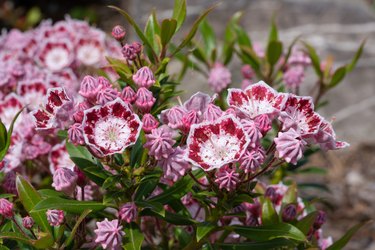
Across the acidic-soiled woodlands and mountains of the Eastern United States grows an evergreen shrub called mountain laurel (Kalmia latifolia). Rather mundane most of the year, it bursts into bud and flower anytime from middle to late spring, bearing rosy pink to white flowers. Among North America's most ornamental native flowering shrubs, mountain laurels are perennials in U.S. Department of Agriculture plant hardiness zones 4 through 9.
Tip
The mountain laurel is an evergreen shrub that most often blooms in May and June, although it can start blooming from mid to late spring. The uniquely shaped flowers can range from white to various rose pink shades, filling the branches with beautiful blooms.
Video of the Day
Mountain Laurel Growing Range
Mountain laurel grows where the winters are cool enough to force a dormancy period, with temperatures that dip anywhere into the 15 to minus 15 degrees Fahrenheit range. The native range of the shrub extends from Southeast Mississippi northward to Indiana and Ohio and northeastward to Norfolk, Virginia, and up to Southern Maine. It occurs in lowlands and in mountains, affecting its precise timing of flowering each spring. It grows well in gardens in other parts of the country with moist, acidic soil, humid air and appropriate temperatures.
Video of the Day
Mountain Laurel Flowering Season
The lower the elevation and latitude, the earlier the mountain laurel blooms. Shrubs bloom anytime from mid-April to the summer solstice with May and June being the most common time for flowering.
In the Deep South, in USDA zone 8, flowering commences in mid-April and peaks just before May 1. In zone 7, flowering starts around May 1 and peaks in the second week. In higher elevations and farther north in zone 6, blooming peaks in middle to late May, and into early June in areas with higher elevation or farthest north in latitude. Across inland New England, mostly in USDA zone 5, flowering occurs around mid-June.
Factors Affecting Flowering Time
The precise timing of mountain laurel flowering varies year to year based on seasonal weather patterns. While average flowering time frames may be deduced for any region, a cool, wet and cloudy spring can delay flowering one or two weeks. Conversely, an unusually warm spring with lots of sunny weather moves the flowering season earlier by seven to 14 days. Once flowers open, temperatures between 50 and 75 F make blossoms last the longest. Heat, wind and heavy downpours shorten flower cluster longevity.
Mountain Laurel Flowering Features
The pointed flower buds develop and swell on the mountain laurel over two weeks prior to opening. The buds themselves lend an attractive textural and color contrast to the oval green leaves. Buds often are dark red to rosy pink and open to reveal lighter colored blossoms that range from coral red to medium pink or white. The flowers display unique maroon or purple patterns on the petals in dots or streaks.
The mountain laurel is unique in that the delicate blossoms have fused petals creating a distinct bell-like shape. Flowers individually open in the bud cluster, essentially covering the branches with blossoms once the shrub starts to bloom.
Pruning Mountain Laurel
Mountain laurel doesn't need much pruning unless it gets too large for your space. The shrub grows slowly, averaging less than 12 inches of growth each year and reaching a mature size of 7 to 15 feet tall and wide. Use sanitized pruning shears to control the size in late winter or early spring before the new growth appears.
Another form of pruning for the mountain laurel is deadheading the spent flowers. Each shrub can produce thousands of seeds each year. When you deadhead the shrub by pinching off the old flowers, you shift its energy from reproduction to producing blooms for the following year.